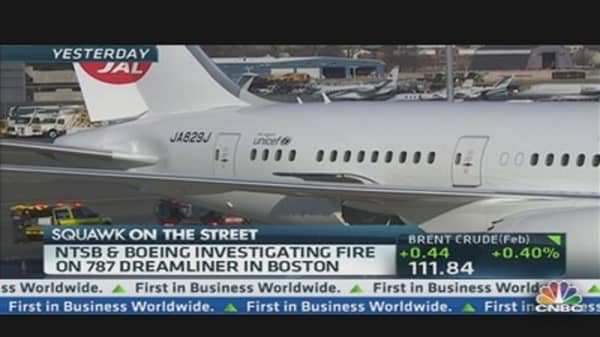As Federal investigators probe the exact cause of a fire on board a parked 787 Dreamliner at Boston's Logan Airport, there are growing questions about the airplane's complex electronics.
The fire in Boston was in an electrical equipment compartment, an area that has been at the center of problems for other Dreamliners.
"If I were an airline flying this plane, I would be worried," said Hans Weber, president of TECOP International Inc., and aviation consultant. "This is a long haul airplane designed to fly across the world. If they (investigators) can't pinpoint the cause of this fire and determine it won't happen again, there's a serious problem." (Read More: Dreamliner Mishaps Put Boeing Under Spotlight .)
NTSB Investigation
The fire on a JAL Dreamliner was detected shortly after the plane landed in Boston following a flight from Tokyo on Monday. The 173 passengers and 11 crew members had already exited the aircraft. A short time later smoke was noticed in the cabin later by a mechanic doing a walk-through. Fire crews were called and put out a small fire involving the a lithium ion battery in the plane's auxiliary power unit.
The NTSB has dispatched investigators to check out the plane while Boeing sent a technical team also to look into what happened.
"We are aware of the event and we are working with our customer," said Marc Birtel, a Boeing spokesperson. (Read More: Dreamliner: Inside the World's Most Anticipated Airplane .)
There's no telling how long the NTSB investigation will take. It is likely the probe will focus on two issues: the Dreamliner's lithium ion batteries and its complex electronics.
Lithium ion battery concerns on planes
The FAA has long been focused on making sure the Dreamliner and any other plane using lithium ion batteries follow strict guidelines due to the potential flammability of the batteries.
In 2007, the FAA issued rules about lithium batteries writing, "In general, lithium ion batteries are significantly more susceptible to internal failures that can result in self-sustaining increases in temperature and pressure. ... The metallic lithium can ignite, resulting in a self-sustaining fire or explosion."
Hans Weber said it's possible there was a problem with one of the lithium ion batteries on the Dreamliner in Boston, but he added, "If this was a problem with the lithium ion batteries, that would be a first."
(Read More: The Dreamliner Makes Its First US Airline Flight.)
Meanwhile, investigators are certain to check if this fire is the latest incident related to problems with the Dreamliner's complex electronics.
In December, United Airlines grounded one its Dreamliners due to problems with an electrical panel. That plane is once again flying.
"My fear is there is some problem in the power conditioning system on the Dreamliner," Weber said. "That's where I'd be inclined to look."
Long-term damage to Boeing & the Dreamliner
This is not the first high profile problem involving the Dreamliner. Given its complexity and technological advancements, launching the 787 has been filled with delays and setbacks. (Read More: Is the Boeing 787 Dreamliner Truly a Game Changer?)
Now that the Dreamliner is in service with more than 40 delivered to airlines around the world, these latest problems are magnified. They also come as Boeing is in the midst of ramping up production of the Dreamliner. The company still has a backlog of more than 800 Dreamliner orders and so far there's no indication airlines have cancelled 787 orders because of the recent problems.
"There are many new technologies in this plane, so inevitably there will be many glitches," said Richard Aboulafia, an aviation consultant with the Teal Group in Washington, D.C. "But put the words 'fire' and 'new jetliner' together in a sentence and you're bound to scare travelers and airlines. Boeing will be able to make this situation right, but they need to act fast to avoid serious problems with customers."
—By CNBC's Phil LeBeau; Follow him on Twitter @LeBeauCarNews





